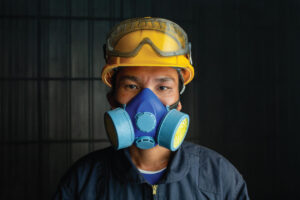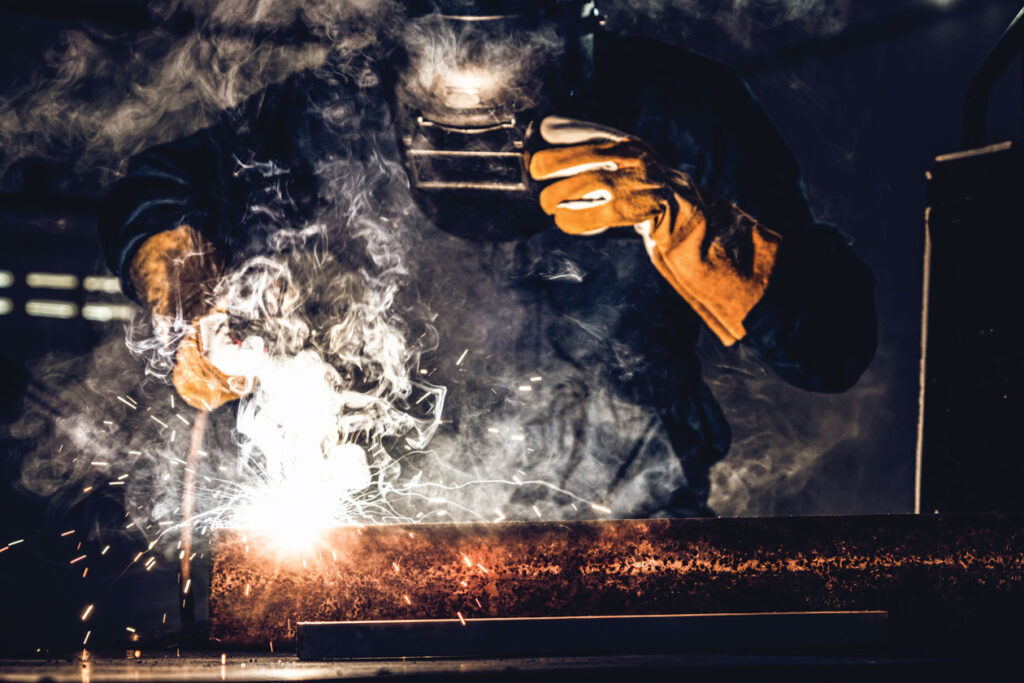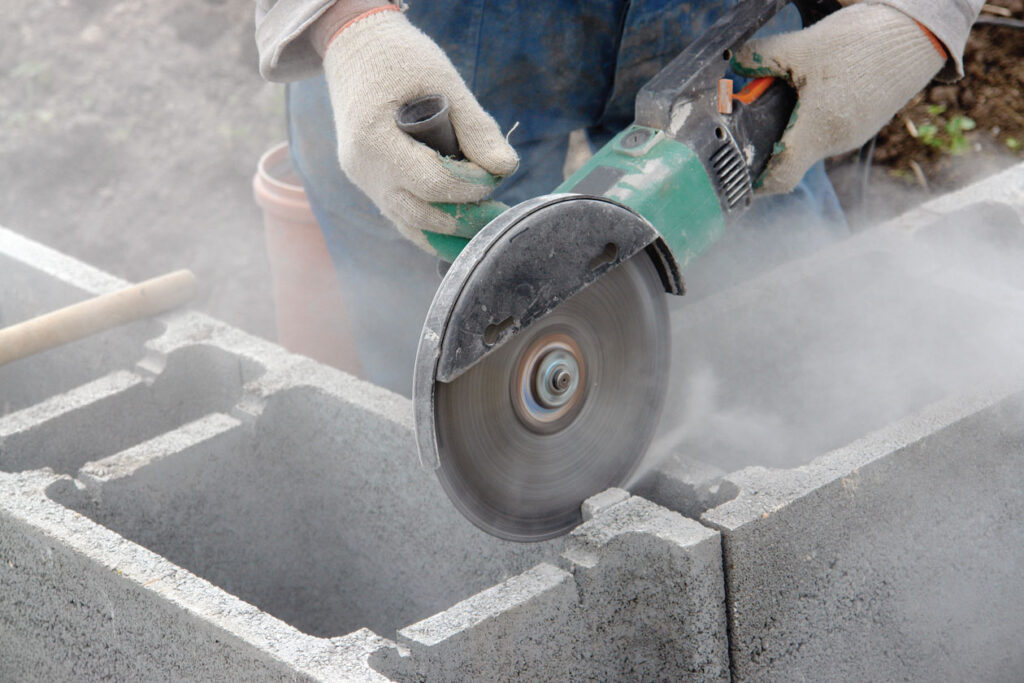Considerations for Dust and Fume Control in the Workplace
By: Ashley Griesenbrock, CIH, CSP, Contributor
You may think of “dust” as just a nuisance in the workplace; however, dusts and fumes in the workplace can pose a significant hazard to employees and even equipment.
Dusts and fumes can be found in almost any industry or workplace setting. Dusts are defined as mechanically produced solid particles (crushing, grinding, sweeping, etc.). Fumes are defined as solid particles generated by condensation from the gaseous state, generally after volatilization from melted substance (welding, hot work, etc.).

When engineering controls are not being implemented, or are not an option, respiratory protection may be needed to keep employee exposures within OSHA limits. (photo courtesy Adobe Stock)
Hazards of Dust Exposure
When dust is breathed in through the nose, only a small fraction reaches the lungs. The size of the particle determines how far into the respiratory tract it will travel. Smaller particles (respirable) can make their way past the nose and the respiratory tract and enter the lungs. Respirable crystalline silica is one example of a severely hazardous particulate that deposits in the deepest parts of the lungs. This can cause scaring and fibroids of the lungs (fibrosis); fibrosis caused by crystalline silica is called silicosis.
Slips, trips and falls may not seem like a hazard of dust exposure; however, depending on the type of dust and flooring, accumulated dust can cause slick walkways.
Employee health is not the only concern when talking about dust in the workplace. Accumulation of dust inside equipment can dramatically affect operations. Dust accumulation on electrical and instrumental equipment can act as an insulator—resulting in overheating and, possibly, fire.
Hazards of Fume Exposure
Fumes are generally associated with welding operation. Welding fumes contain metals such as aluminum, arsenic, copper, lead, manganese and zinc. Exposures to welding fumes can result in short-term symptoms, such as shortness of breath, nausea and metal fume fever. Long-term exposure to welding fumes can cause extensive lung damage, kidney damage, and cancer of the lungs, larynx and urinary tract. Welding fumes are not the only fumes of concern. Not all fume hazards originate from large industrial settings; smaller operations, like nail and hair salons, can also produce harmful fumes for employees.

Welding fumes contain metals such as aluminum, arsenic, copper, lead, manganese and zinc. Exposures to such fumes can result in short-term symptoms, such as shortness of breath, nausea and metal fume fever. Long-term exposure can cause extensive lung damage, kidney damage, and cancer of the lungs, larynx and urinary tract. (photo courtesy Adobe Stock)
Method of Dust Control:
- Local exhaust ventilation (LEV) – Dusts are captured directly at the source and filtered/exhausted. Typically, LEV units are equipped with hoses that can be positioned to best capture smaller sources of dust. (Examples include grinding, manual material mixing and manual product charging.)
- Exhaust ventilation (canopy hoods) – Dusts are pulled away from the work area and into ductwork above the work area.
- Downdraft table – Ventilation built-in below a work bench or table that draws dusts down and away from the employees. (Examples include woodworking, sanding and metalworking.)
- Exhaust and filter – Large volumes of air are captured and passed through a filter and recirculated or vented to the outside.
- General ventilation – Fresh air is naturally or mechanically brought into the workspace to dilute airborne dust. (Examples include lesser concentrations of dust being generated in a larger area.)
- Integrated – Small vacuum hoses attached to an instrument directly at the source of dust. (Examples include respirable crystalline silica grinding/cutting tools.)
Methods for Fume Control:
- LEV – Ventilation hose that can be moved to best capture fumes. These can have stationary bases or be mobile units. These are commonly used for operations that may not have one stationary workspace. (Examples include portable welding stations, grinding or sanding large pieces material.)
- Fume removal/separation – Air scrubbers or filters are incorporated into the exhaust system.(Examples include workplaces with fumes being generated in lesser concentrations throughout.)

Engineering controls are the best choice for reducing employee exposures to various hazardous dusts. (photo courtesy Adobe Stock)
Considerations Before Installing Controls:
- Do you have employee exposure data to help determine appropriate level of ventilation needed?
- Have you performed a dust hazard analysis for potentially combustible dust?
- Does your facility product dust that is classified as an air pollutant? (A baghouse dust collector may be necessary.)
- Discuss potential engineering controls with employees; installing controls that employees understand and are willing to use can be a game changer!
- Do you have potentially flammable vapors that could potentially be captured by ventilation controls. Additional considerations need to be made when exhausting flammable vapors.
While dusts and fumes may not be the first thought when thinking of workplace hazards, they shouldn’t be ignored. Dust exposures are not limited to heavy industrial settings. Employees working in food manufacturing, mixing spices and flour, and industrial food fryer smoke are just a few more examples of how dust exposure can be everywhere.
Lastly, engineering controls are the best choice for reducing employee exposures. When engineering controls are not being implemented, or are not an option, respiratory protection may be needed to keep employee exposures within OSHA limits.
Ashley Griesenbrock, CIH, CSP, is an Industrial Hygiene Consultant at Safex, an EHS consulting firm in Columbus, Ohio. She specializes in inhalation exposure assessments for metals, particulates, silica and VOCs, and she trains teams on various industrial hygiene and safety topics.
Share on Socials!
Are You Ready to Rescue?
Computer Use Guide
Mitigating the Hidden Risks of Start-up and Shutdown Operations
Leaders in Industrial Hygiene
Council for Accreditation in Occupational Hearing Conservation (CAOHC)
Subscribe!
Sign up to receive our industry publications for FREE!









